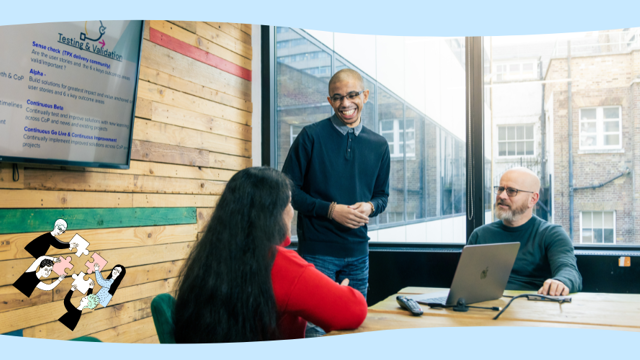For those new to the technology, embarking on an intelligent automation (also known as intelligent RPA) project can be daunting. But it doesn't have to be.
Here are our five top tips for what to think about before you get started.
1) Are your people on board with your automation project?
If you're mostly thinking about your automation project in terms of technology, then think again... Although technology might provide us with the tools to automate, building the technical solution is actually the easiest part of any project. Much more difficult is the change management aspect — making automation part of your organisation's DNA. This involves understanding the impact it will have on the way the business works and on your people.
Many people understandably have concerns about the idea of automation, whether that's hesitancy around the new and unknown or the real fear that a robot might replace them.
It is extremely important to communicate openly about the project, establishing two-way channels of communication, space for people to ask questions, and an understanding of the benefits automation will bring to your workforce. The success of any technology depends on the full support of the people who will use it, so get them on board as soon as you can.
Starting small and scaling quickly with your automation project is a really good way of rapidly releasing value back to the business — this can also boost engagement as staff are able to see the benefits for themselves.
2) What's your long term automation strategy?
Senior leaders often turn to automation as a way of gaining efficiencies in a specific department or process. Approaching it in this way — as a point solution — will release staff time and provide cost savings. But it doesn't deliver the most impactful benefits in the long term.
Instead, the best results are gained when automation is approached at the level of the entire organisation. This ensures that automated processes don't get caught up in residual manual bottlenecks, and typically enables the automation of many more processes than expected.
Ideally, organisations should aim to become automation first, automating as many existing processes as possible, and — when any new tasks or roles are required — turning to automation in the first instance. This is true strategic automation, and it will unlock huge productivity gains for your organisation.
3) What will your team do once their time is released?
This might seem like an obvious question, but it's worth getting on top of. Automation projects are unusual in the sense that it is possible to provide accurate and detailed figures on return on investment from the outset.
You'll have a clear sense of the time and costs you will save, so it's important to know where you will redeploy your staff, and how they can best add more value to the organisation. Asking this question will also help you to pin down why you are pursuing this project, and think more clearly about its purpose.
4) How will you communicate the benefits of automation?
Once your automation is up and running, and you've begun to reap the benefits – shout them from the rooftops. Show off your metrics including time and costs saved, improved staff satisfaction, and that all important anecdotal evidence about how employees' working lives have been transformed. Engaging with senior stakeholders, ideally at board level, will help to prove the value of automation and secure budget for future projects.
(Hopefully, you'll get a thank you for all your hard work too...)
5) What comes next?
You've laid the groundwork, built a software robot, and set it to work. So what's next? If your automation project has been a success, you'll likely want to do more. But working with external automation experts – whilst important for getting you started – isn't cost effective in the long run.
You'll probably want to look into bringing automation capability in house, and developing a community of excellence. This might be through upskilling existing teams, or by new hires. Whatever you choose, know that your external partner should transfer their knowledge to you across the entire project. This is something we at TPXimpact do as standard, as it makes for successful, sustainable digital transformation.
Automation for the win
So there you have it — five key pointers for automation, which will stand you in good stead to make your automation journey as successful as possible.
If you'd like more information, you'll find lots more resources across our website, including the success stories of organisations we've partnered with. To discover how automation can help your specific needs, get in touch and we'll be more than happy to help.
Our recent insights

Shaping product and service teams
How cultivating product and service teams to support the needs of the entire product lifecycle can ensure brilliant delivery.
Read more
Building ‘The Chatbot’ - Our experience with GenAI
Learn how we harnessed to power of Generative AI to build our very own chatbot.
Read more
How digital transformation can improve access to justice
Jay Bangle discusses the power technology has to open up justice services to everyone
Read more

